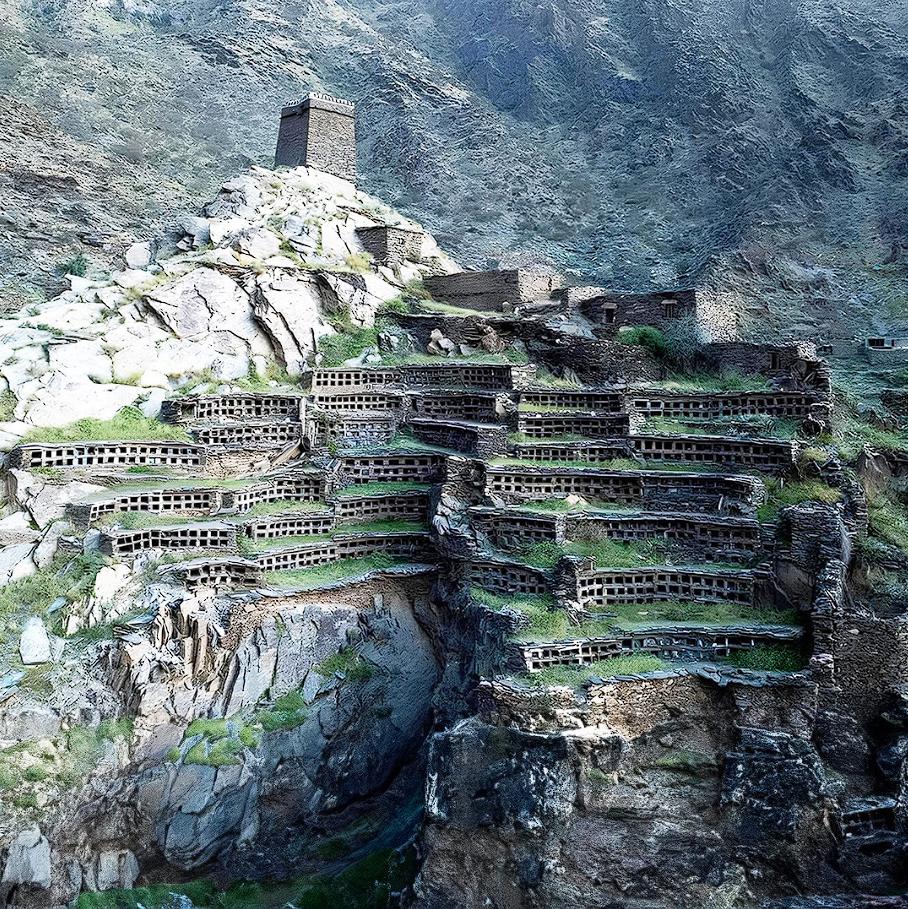Nestled within the rugged Sarawat Mountains of Saudi Arabia, an extraordinary discovery has been made: an 800-year-old stone apiary. This ancient site not only showcases the remarkable ingenuity and adaptability of medieval beekeepers but also serves as a historical treasure trove of sustainable apiculture practices, a sweet legacy amidst the harsh desert landscape.
Architectural Harmony: A Symphony of Sweetness in the Mountains
- A Medieval Honey Production Hub: “The Buzz of a Thousand Bees”:
- Archaeologists have determined that this apiary, constructed around 1200 AD, was capable of housing up to 1,200 beehives. “Imagine the constant buzz of thousands of bees, the tireless work of the apiarists, the transport of honey-laden vessels, all creating a sweet symphony amidst the wild mountains,” describes Dr. Ahmed Al-Zahrani, an expert in Arabian agricultural history, painting a vivid picture of the apiary’s bustling heyday.
- This was not merely a site for honey extraction; it was a large-scale production center, reflecting the advanced state of apiculture in the region and the prosperity of the ancient Arabian communities.
- Ingenious Terraced Design: “An Artful Blend of Nature and Craft”:
- The apiary’s meticulously designed stone terraces, which ingeniously utilized the mountainous terrain to optimize beekeeping, are a testament to the builders’ skill. “These stone terraces are not just functional; they are a work of art, a testament to the harmonious blend of human ingenuity and nature,” observes Fatima Al-Shehri, an architect specializing in ancient structures.
- Experts commend the ancients’ ability to integrate architecture with the natural environment, creating a landscape of both practical utility and aesthetic beauty.
- Fortified Protection for “Liquid Gold”: “A Treasure to Be Safeguarded”:
- To safeguard this precious resource from thieves and wildlife, a protective fortress was constructed around the apiary. “Honey here was not just food; it was ‘liquid gold,’ a commodity of high economic and cultural value. Like any treasure, it needed protection,” explains Abdullah Al-Ghamdi, a local resident.
- This highlights the importance of honey in ancient Arabian society, not just as sustenance but as a symbol of wealth and power.
Sustainable Apiculture: Lessons From the Past for the Future
- Natural Harmony in Beekeeping: “Working in Accordance With Nature”:
- Research indicates that the apiary employed sustainable beekeeping methods, respecting the ecological balance. “They worked in accordance with nature, avoiding overexploitation and honoring the ecosystem’s equilibrium,” notes Dr. Salma Al-Otaibi, an expert in ancient environmental practices.
- This provides valuable lessons for modern apiculture, especially in an era of increasing environmental awareness and the need for sustainable practices.
- Timeless Ingenuity: “A Testament to Human Resourcefulness”:
- The apiary is a testament to the resourcefulness and adaptability of humans in challenging environments. “This is a demonstration of human ingenuity, a way to overcome obstacles and thrive in harsh conditions,” shares Khalid Al-Dosari, an engineer involved in the site’s preservation.
- The techniques and methods used here remain relevant today, showcasing the wisdom and foresight of the ancients.
- Harnessing Nature’s Bounty: “Transforming the Landscape Into a Resource”:
- The apiary’s success in honey production reflects the region’s abundance and the beekeepers’ skill in utilizing its resources. “They transformed what the landscape offered into a precious resource, a gift from nature to be cherished and protected,” says Mohammed Al-Qahtani, a traditional beekeeper.
- This underscores the deep connection between humans and nature, a relationship that warrants continued respect and cultivation.
A Timeless Legacy: Bridging Past and Future
- A Captivating Destination: “A Journey Into History”:
- Today, the apiary attracts visitors from around the world, offering a unique glimpse into the lives and practices of those who lived centuries ago. “Stepping into this place is like embarking on a journey into history, uncovering the secrets of a lost world,” recounts Noura Al-Mutairi, a visitor from Riyadh.
- It’s a chance to explore the unique history and culture of Saudi Arabia, and to marvel at the architectural beauty and natural splendor of the site.
- Architectural and Natural Harmony: “A Stunning Tapestry”:
- The blend of ancient architecture and the stunning natural landscape creates a captivating experience for all who visit. “This is a stunning tapestry, were architecture and nature blend together” says Khaled Al-Harbi a documentary film director.
- It’s an ideal destination for those seeking to immerse themselves in history, culture, and nature.
- A Message for Future Generations: “A Reminder of Ingenuity and Wisdom”:
- The apiary serves as a powerful reminder of human ingenuity and the importance of sustainable practices. “This is not just history; it’s a message for the future, a reminder of the ingenuity and wisdom that can be found in the past,” states Fahad Al-Dossary, a community leader.
- It’s a source of inspiration for building a sustainable future, where humans and nature coexist in harmony.
The ancient apiary in Saudi Arabia is more than a historical site; it’s a testament to human creativity, sustainable living, and the enduring connection between people and the natural world. It stands as a valuable cultural heritage, worthy of preservation and appreciation.

CÁC TIN KHÁC
Mary Walton: The Forgotten Inventor Who Helped Clean Up America’s Cities
Tomb of Queen Nefertari in the Valley of the Queens, Egypt
Discover the Hypostyle Hall of the Temple of Hathor at Dendera
Venus de Losange: Unveiling the Mystery of a 20,000-Year-Old Paleolithic Icon